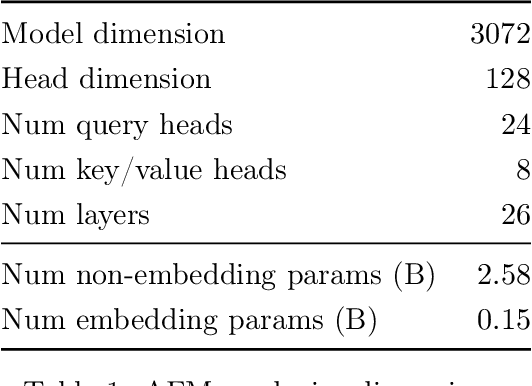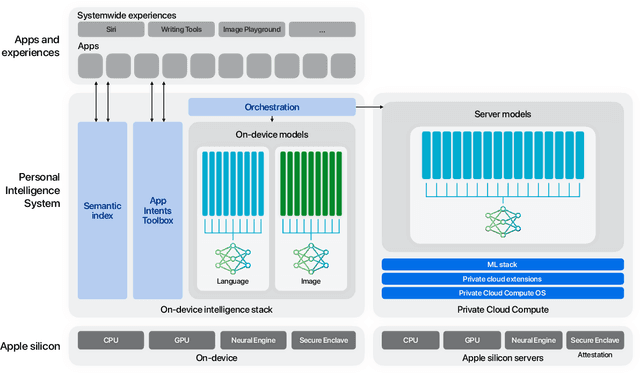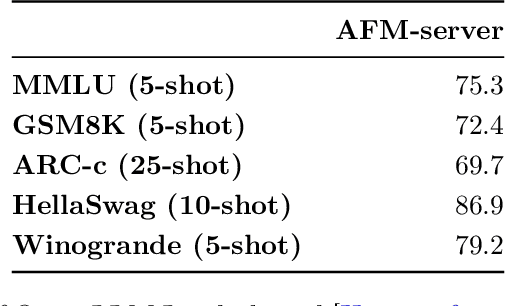Xianzhi Du
Finding Fantastic Experts in MoEs: A Unified Study for Expert Dropping Strategies and Observations
Apr 10, 2025Abstract:Sparsely activated Mixture-of-Experts (SMoE) has shown promise in scaling up the learning capacity of neural networks. However, vanilla SMoEs have issues such as expert redundancy and heavy memory requirements, making them inefficient and non-scalable, especially for resource-constrained scenarios. Expert-level sparsification of SMoEs involves pruning the least important experts to address these limitations. In this work, we aim to address three questions: (1) What is the best recipe to identify the least knowledgeable subset of experts that can be dropped with minimal impact on performance? (2) How should we perform expert dropping (one-shot or iterative), and what correction measures can we undertake to minimize its drastic impact on SMoE subnetwork capabilities? (3) What capabilities of full-SMoEs are severely impacted by the removal of the least dominant experts, and how can we recover them? Firstly, we propose MoE Experts Compression Suite (MC-Suite), which is a collection of some previously explored and multiple novel recipes to provide a comprehensive benchmark for estimating expert importance from diverse perspectives, as well as unveil numerous valuable insights for SMoE experts. Secondly, unlike prior works with a one-shot expert pruning approach, we explore the benefits of iterative pruning with the re-estimation of the MC-Suite criterion. Moreover, we introduce the benefits of task-agnostic fine-tuning as a correction mechanism during iterative expert dropping, which we term MoE Lottery Subnetworks. Lastly, we present an experimentally validated conjecture that, during expert dropping, SMoEs' instruction-following capabilities are predominantly hurt, which can be restored to a robust level subject to external augmentation of instruction-following capabilities using k-shot examples and supervised fine-tuning.
IDEA Prune: An Integrated Enlarge-and-Prune Pipeline in Generative Language Model Pretraining
Mar 07, 2025Abstract:Recent advancements in large language models have intensified the need for efficient and deployable models within limited inference budgets. Structured pruning pipelines have shown promise in token efficiency compared to training target-size models from scratch. In this paper, we advocate incorporating enlarged model pretraining, which is often ignored in previous works, into pruning. We study the enlarge-and-prune pipeline as an integrated system to address two critical questions: whether it is worth pretraining an enlarged model even when the model is never deployed, and how to optimize the entire pipeline for better pruned models. We propose an integrated enlarge-and-prune pipeline, which combines enlarge model training, pruning, and recovery under a single cosine annealing learning rate schedule. This approach is further complemented by a novel iterative structured pruning method for gradual parameter removal. The proposed method helps to mitigate the knowledge loss caused by the rising learning rate in naive enlarge-and-prune pipelines and enable effective redistribution of model capacity among surviving neurons, facilitating smooth compression and enhanced performance. We conduct comprehensive experiments on compressing 2.8B models to 1.3B with up to 2T tokens in pretraining. It demonstrates the integrated approach not only provides insights into the token efficiency of enlarged model pretraining but also achieves superior performance of pruned models.
CLIP-UP: A Simple and Efficient Mixture-of-Experts CLIP Training Recipe with Sparse Upcycling
Feb 03, 2025



Abstract:Mixture-of-Experts (MoE) models are crucial for scaling model capacity while controlling inference costs. While integrating MoE into multimodal models like CLIP improves performance, training these models is notoriously challenging and expensive. We propose CLIP-Upcycling (CLIP-UP), an efficient alternative training strategy that converts a pre-trained dense CLIP model into a sparse MoE architecture. Through extensive experimentation with various settings and auxiliary losses, we demonstrate that CLIP-UP significantly reduces training complexity and cost. Remarkably, our sparse CLIP B/16 model, trained with CLIP-UP, outperforms its dense counterpart by 7.2% and 6.6% on COCO and Flickr30k text-to-image Recall@1 benchmarks respectively. It even surpasses the larger CLIP L/14 model on this task while using only 30% of the inference FLOPs. We further demonstrate the generalizability of our training recipe across different scales, establishing sparse upcycling as a practical and scalable approach for building efficient, high-performance CLIP models.
MM1.5: Methods, Analysis & Insights from Multimodal LLM Fine-tuning
Sep 30, 2024Abstract:We present MM1.5, a new family of multimodal large language models (MLLMs) designed to enhance capabilities in text-rich image understanding, visual referring and grounding, and multi-image reasoning. Building upon the MM1 architecture, MM1.5 adopts a data-centric approach to model training, systematically exploring the impact of diverse data mixtures across the entire model training lifecycle. This includes high-quality OCR data and synthetic captions for continual pre-training, as well as an optimized visual instruction-tuning data mixture for supervised fine-tuning. Our models range from 1B to 30B parameters, encompassing both dense and mixture-of-experts (MoE) variants, and demonstrate that careful data curation and training strategies can yield strong performance even at small scales (1B and 3B). Additionally, we introduce two specialized variants: MM1.5-Video, designed for video understanding, and MM1.5-UI, tailored for mobile UI understanding. Through extensive empirical studies and ablations, we provide detailed insights into the training processes and decisions that inform our final designs, offering valuable guidance for future research in MLLM development.
Apple Intelligence Foundation Language Models
Jul 29, 2024



Abstract:We present foundation language models developed to power Apple Intelligence features, including a ~3 billion parameter model designed to run efficiently on devices and a large server-based language model designed for Private Cloud Compute. These models are designed to perform a wide range of tasks efficiently, accurately, and responsibly. This report describes the model architecture, the data used to train the model, the training process, how the models are optimized for inference, and the evaluation results. We highlight our focus on Responsible AI and how the principles are applied throughout the model development.
Revisiting MoE and Dense Speed-Accuracy Comparisons for LLM Training
May 23, 2024



Abstract:Mixture-of-Experts (MoE) enjoys performance gain by increasing model capacity while keeping computation cost constant. When comparing MoE to dense models, prior work typically adopt the following setting: 1) use FLOPs or activated parameters as a measure of model complexity; 2) train all models to the same number of tokens. We argue that this setting favors MoE as FLOPs and activated parameters do not accurately measure the communication overhead in sparse layers, leading to a larger actual training budget for MoE. In this work, we revisit the settings by adopting step time as a more accurate measure of model complexity, and by determining the total compute budget under the Chinchilla compute-optimal settings. To efficiently run MoE on modern accelerators, we adopt a 3D sharding method that keeps the dense-to-MoE step time increase within a healthy range. We evaluate MoE and dense LLMs on a set of nine 0-shot and two 1-shot English tasks, as well as MMLU 5-shot and GSM8K 8-shot across three model scales at 6.4B, 12.6B, and 29.6B. Experimental results show that even under these settings, MoE consistently outperform dense LLMs on the speed-accuracy trade-off curve with meaningful gaps. Our full model implementation and sharding strategy will be released at~\url{https://github.com/apple/axlearn}
MM1: Methods, Analysis & Insights from Multimodal LLM Pre-training
Mar 22, 2024



Abstract:In this work, we discuss building performant Multimodal Large Language Models (MLLMs). In particular, we study the importance of various architecture components and data choices. Through careful and comprehensive ablations of the image encoder, the vision language connector, and various pre-training data choices, we identified several crucial design lessons. For example, we demonstrate that for large-scale multimodal pre-training using a careful mix of image-caption, interleaved image-text, and text-only data is crucial for achieving state-of-the-art (SOTA) few-shot results across multiple benchmarks, compared to other published pre-training results. Further, we show that the image encoder together with image resolution and the image token count has substantial impact, while the vision-language connector design is of comparatively negligible importance. By scaling up the presented recipe, we build MM1, a family of multimodal models up to 30B parameters, including both dense models and mixture-of-experts (MoE) variants, that are SOTA in pre-training metrics and achieve competitive performance after supervised fine-tuning on a range of established multimodal benchmarks. Thanks to large-scale pre-training, MM1 enjoys appealing properties such as enhanced in-context learning, and multi-image reasoning, enabling few-shot chain-of-thought prompting.
From Scarcity to Efficiency: Improving CLIP Training via Visual-enriched Captions
Oct 11, 2023Abstract:Web-crawled datasets are pivotal to the success of pre-training vision-language models, exemplified by CLIP. However, web-crawled AltTexts can be noisy and potentially irrelevant to images, thereby undermining the crucial image-text alignment. Existing methods for rewriting captions using large language models (LLMs) have shown promise on small, curated datasets like CC3M and CC12M. Nevertheless, their efficacy on massive web-captured captions is constrained by the inherent noise and randomness in such data. In this study, we address this limitation by focusing on two key aspects: data quality and data variety. Unlike recent LLM rewriting techniques, we emphasize exploiting visual concepts and their integration into the captions to improve data quality. For data variety, we propose a novel mixed training scheme that optimally leverages AltTexts alongside newly generated Visual-enriched Captions (VeC). We use CLIP as one example and adapt the method for CLIP training on large-scale web-crawled datasets, named VeCLIP. We conduct a comprehensive evaluation of VeCLIP across small, medium, and large scales of raw data. Our results show significant advantages in image-text alignment and overall model performance, underscoring the effectiveness of VeCLIP in improving CLIP training. For example, VeCLIP achieves a remarkable over 20% improvement in COCO and Flickr30k retrieval tasks under the 12M setting. For data efficiency, we also achieve a notable over 3% improvement while using only 14% of the data employed in the vanilla CLIP and 11% in ALIGN.
Ferret: Refer and Ground Anything Anywhere at Any Granularity
Oct 11, 2023Abstract:We introduce Ferret, a new Multimodal Large Language Model (MLLM) capable of understanding spatial referring of any shape or granularity within an image and accurately grounding open-vocabulary descriptions. To unify referring and grounding in the LLM paradigm, Ferret employs a novel and powerful hybrid region representation that integrates discrete coordinates and continuous features jointly to represent a region in the image. To extract the continuous features of versatile regions, we propose a spatial-aware visual sampler, adept at handling varying sparsity across different shapes. Consequently, Ferret can accept diverse region inputs, such as points, bounding boxes, and free-form shapes. To bolster the desired capability of Ferret, we curate GRIT, a comprehensive refer-and-ground instruction tuning dataset including 1.1M samples that contain rich hierarchical spatial knowledge, with 95K hard negative data to promote model robustness. The resulting model not only achieves superior performance in classical referring and grounding tasks, but also greatly outperforms existing MLLMs in region-based and localization-demanded multimodal chatting. Our evaluations also reveal a significantly improved capability of describing image details and a remarkable alleviation in object hallucination. Code and data will be available at https://github.com/apple/ml-ferret
Compressing LLMs: The Truth is Rarely Pure and Never Simple
Oct 02, 2023Abstract:Despite their remarkable achievements, modern Large Language Models (LLMs) encounter exorbitant computational and memory footprints. Recently, several works have shown significant success in training-free and data-free compression (pruning and quantization) of LLMs achieving 50-60% sparsity and reducing the bit-width down to 3 or 4 bits per weight, with negligible perplexity degradation over the uncompressed baseline. As recent research efforts are focused on developing increasingly sophisticated compression methods, our work takes a step back, and re-evaluates the effectiveness of existing SoTA compression methods, which rely on a fairly simple and widely questioned metric, perplexity (even for dense LLMs). We introduce Knowledge-Intensive Compressed LLM BenchmarK (LLM-KICK), a collection of carefully-curated tasks to re-define the evaluation protocol for compressed LLMs, which have significant alignment with their dense counterparts, and perplexity fail to capture subtle change in their true capabilities. LLM-KICK unveils many favorable merits and unfortunate plights of current SoTA compression methods: all pruning methods suffer significant performance degradation, sometimes at trivial sparsity ratios (e.g., 25-30%), and fail for N:M sparsity on knowledge-intensive tasks; current quantization methods are more successful than pruning; yet, pruned LLMs even at $\geq 50$% sparsity are robust in-context retrieval and summarization systems; among others. LLM-KICK is designed to holistically access compressed LLMs' ability for language understanding, reasoning, generation, in-context retrieval, in-context summarization, etc. We hope our study can foster the development of better LLM compression methods. All our related codes are planed to be open-sourced.
 Add to Chrome
Add to Chrome Add to Firefox
Add to Firefox Add to Edge
Add to Edge